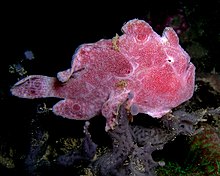| Fowlerichthys | |
|---|---|

| |
| Ocellated frogfish (F. ocellatus) | |
| Scientific classification | |
| Domain: | Eukaryota |
| Kingdom: | Animalia |
| Phylum: | Chordata |
| Class: | Actinopterygii |
| Order: | Lophiiformes |
| Family: | Antennariidae |
| Subfamily: | Antennariinae |
| Genus: | Fowlerichthys T. Barbour, 1941 |
| Type species | |
| Fowlerichthys floridanus T. Barbour, 1941 | |
| Species | |
|
5, See below. | |
| Synonyms | |
| |
Fowlerichthys is a genus of marine ray-finned fishes belonging to the family Antennariidae, the frogfishes. The fishes in this genus are found the Atlantic, Indian and Pacific Oceans.
Taxonomy
Fowlerichthys was first proposed as a monospecific genus in 1941 by the American zoologist Thomas Barbour when he described Fowlerichthys floridanus which he also designated as its type species. F. floridanus is now considered to be a junior synonym of Antennarius radiosus described in 1896 by Samuel Garman with a type locality of Key West in Florida. Some authorities classify this genus in the subfamily Antennariinae within the family Antennariidae. However, the 5th edition of Fishes of the World does not recognise subfamilies within the Antennariidae, classifying the family within the suborder Antennarioidei within the order Lophiiformes, the anglerfishes.
Etymology
Fowlerichthys combines Fowler, honouring the American ichthyologist Henry Weed Fowler of the Academy of Natural Sciences of Philadelphia who gave Barbour the type specimen of F. floridanus, with ichthys, which means fish.
Species
There are currently five recognized species in this genus:
- Fowlerichthys avalonis D. S. Jordan & Starks, 1907 (Roughbar frogfish)
- Fowlerichthys ocellatus Bloch & J. G. Schneider, 1801 (Ocellated frogfish)
- Fowlerichthys radiosus Garman, 1896 (Singlespot frogfish)
- Fowlerichthys scriptissimus D. S. Jordan, 1902 (Calico frogfish)
- Fowlerichthys senegalensis Cadenat, 1959 (Senegalese frogfish)
Characteristics
Fowlerichthys frogfishes have globose rather compressed bodies covered in densely set bifurcated spinules with their eyes placed on the sides of the head. The upwardly pointing mouth has numerous small teeth. The illicium does not have a distinct esca, or lur and any spinules on the illicium are located at its base or along its front edge. The illicium is slight shorter than the second dorsal spine, this present. The rear margins of the dorsal and anal fin membranes have a membrane connecting them to the body on front of the caudal peduncle. The dorsal fin has between 12 and 14 soft rays, all typically having a single fork, with the anal fin having between 7 and 10 similar rays. These are large frogfishes, with the largest species being the ocellated frogfish (F. ocellatus) which has a maximum published total length of 38 cm (15 in) while the smallest is the singlespot frogfsih (Fowlerichthys radiosus) which has a maximum length of 25 cm (9.8 in).
Distribution and habitat
Fowlerichthys frogfishes are found in the warmer waters of the Atlantic, Indian and Pacific Oceans with two species, F. ocellatus and F. radiosus, in the Western Atlantic Ocean, one, F. senegalensis in the Eastern Atlantic Ocean, one F. scriptissimus, in the Indo-West Pacific and one in the Eastern Pacific, F. avalonis. These fishes are typically found in rocky and reef habitats, frequently in the intertidal zone, sometimes on sandy and muddy bottoms and one species F. radiosus, on offshore banks and the deeper waters of the continental shelf.
References
- ^ Eschmeyer, William N.; Fricke, Ron & van der Laan, Richard (eds.). "Genera in the family Antennariidae". Catalog of Fishes. California Academy of Sciences. Retrieved 2 April 2024.
- Eschmeyer, William N.; Fricke, Ron & van der Laan, Richard (eds.). "Species in the genus Fowlerichthys". Catalog of Fishes. California Academy of Sciences. Retrieved 2 April 2024.
- Arnold, R. J.; R. G. Harcourt; and T. W. Pietsch (2014). "A new genus and species of the frogfish family Antennariidae (Teleostei: Lophiiformes: Antennarioidei) from New South Wales, Australia, with a diagnosis and key to the genera of the Histiophryninae". Copeia. 2014 (3): 534–539. doi:10.1643/CI-13-155.
- Nelson, J.S.; Grande, T.C.; Wilson, M.V.H. (2016). Fishes of the World (5th ed.). Hoboken, NJ: John Wiley & Sons. pp. 508–518. doi:10.1002/9781119174844. ISBN 978-1-118-34233-6. LCCN 2015037522. OCLC 951899884. OL 25909650M.
- Christopher Scharpf (14 November 2022). "Order LOPHIIFORMES (part 1): Families LOPHIIDAE, ANTENNARIIDAE, TETRABRACHIIDAE, LOPHICHTHYIDAE, BRACHIONICHTHYIDAE, CHAUNACIDAE and OGCOCEPHALIDAE". The ETYFish Project Fish Name Etymology Database. Christopher Scharpf. Retrieved 2 April 2024.
- ^ Froese, Rainer; Pauly, Daniel (eds.). "Species in genus Fowlerichthys". FishBase. February 2024 version.
- ^ "Genus: Fowlerichthys, Frogfishes". Shorefishes of the Eastern Pacific online information system. Smithsonian Tropical Research Institute. Retrieved 2 April 2024.
- Theodore W Pietsch (2022). "Order Lophiiformes". In Phillip C Heemstra; Elaine Heemstra; David A Ebert; Wouter Holleman; John E Randall (eds.). Coastal Fishes of the Western Indian Ocean (PDF). Vol. 2. South African Institute for Aquatic Biodiversity. pp. 281–307. ISBN 978-1-990951-29-9.
- Froese, Rainer; Pauly, Daniel (eds.). "Fowlerichthys ocellatus". FishBase. February 2024 version.
- Froese, Rainer; Pauly, Daniel (eds.). "Fowlerichthys avalonis". FishBase. February 2024 version.
- Froese, Rainer; Pauly, Daniel (eds.). "Fowlerichthys radiosus". FishBase. February 2024 version.
| Taxon identifiers | |
|---|---|
| Fowlerichthys | |